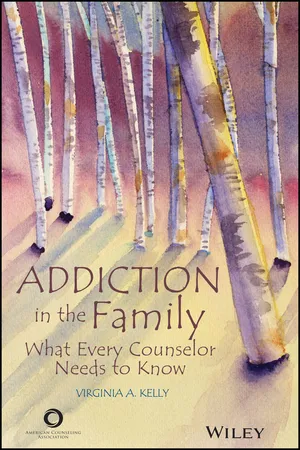Chapter 1
Substance Abuse and SUD: History and Definition
Issues of substance abuse and addiction are not new. In fact, evidence suggests that humans have been using mind-altering substances since the beginning of time (Segal, 2014). However, national awareness of drug addiction as a potential problem emerged slowly. In the United States, the first drug identified as potentially harmful was opium. In response to an increase in the recreational use of opium in San Francisco, the city invoked the first law associated with drugs when it banned opium dens in 1875. This law eventually led to legislation, passed in 1906, requiring accurate labeling of patent medicines containing opium. Subsequently, in 1914, the Harrison Narcotic Act was passed, prohibiting the sale of large doses of opiates or cocaine, except by licensed physicians. This first step at governmental oversight seemed to have an influence on substance abuse, as the use of narcotics and cocaine decreased. In fact, in this spirit of temperance, the 18th Amendment to the Constitution, which prohibited the use of alcohol, was passed in 1919 and remained in effect until it was repealed in 1933 (Stevens & Smith, 2013).
Upon the repeal of Prohibition in the 1930s, drug education emerged as a concept for the first time, and schools began to incorporate educational programs designed to intervene in adolescent use of drugs and alcohol. However, despite these efforts, drinking and drug use increased. In the 1950s, the use of marijuana, amphetamines, and tranquilizers increased dramatically (Brown, 1981). The 1960s was seen as a time of tremendous social upheaval, and there was a perception of increased drug and alcohol use. However, despite this perception, a 1969 Gallup poll revealed that although 48% of American adults felt that drug use was a serious problem within their communities, only 4% had tried marijuana. It was in the 1970s that marijuana use dramatically increased. By 1973, 12% of American adults reported using marijuana, and by 1977, this percentage had doubled (Robison, 2002a).
By 1985, one third of American adults reported using marijuana, and the use of cocaine was on the rise. It was at this time that crack cocaine was introduced. In a 1986 Gallup poll, when asked what the most serious drug problem was within the United States, adults reported crack cocaine above heroin, marijuana, and alcohol. In response, President Ronald Reagan signed the Anti-Drug Abuse Act of 1986, thus declaring the nation's war on drugs, and Nancy Reagan began the “Just Say No” campaign (Robison, 2002b). The 1986 bill imposed mandatory minimum sentences for the possession of controlled substances in an effort to deter the sale and use of the newly introduced synthetic drugs, including crack cocaine. As funding for this initiative became available, programs began to emerge in response to Reagan's call for action. Perhaps the most widely publicized and used of these was the Drug Abuse Resistance Education (DARE) program, which was introduced in schools across the country. DARE and other programs initiated in the 1980s generally included an educational component designed to teach children about the various substances that were being abused along with activities designed to bolster adolescents' refusal skills.
The 1990s was marked by the first reported decrease in drug use since the 1960s. Although 34% of American reported having used marijuana, the 1999 Gallup youth survey showed a decrease in adolescents' trial use of all controlled substances. However, at the same time, club drugs and methamphetamines (often referred to as crystal meth or meth) began to emerge. During the 1990s, drugs like Ecstasy (a designer club drug) were new and perceived as harmless by adolescents. Given the addictive qualities of methamphetamines, the use of such synthetic drugs began to increase. Finally, in the later 1990s, an increase in the use of heroin was seen, as opiate-based prescription drugs hit the market for the treatment of pain (Robison, 2002b).
The United Nations Office on Drugs and Crime (UNODC) released a report in 2008 outlining the trends in drug usage between the years of 2000 and 2008. During that period, the United States saw a marked increase in the use of illicit drugs from 11% of the adult population in 2000 to 15% in 2008. Specifically, there was a moderate increase in the use of Ecstasy-type and other synthetic drugs and a significant increase in the use of marijuana, hashish, and pain relievers (UNODC, 2008).
Since 2008, the use of heroin has increased; in addition, the face of heroin users has changed over the decades. Whereas the typical heroin user in the 1960s was found to be male and young, with a mean age of 16.5, the heroin addict of today tends to be older, with a mean age of 22.9, and may be male or female. In addition, the use of heroin has moved from predominantly urban areas to the suburbs. Finally, research suggested that the road to heroin use was historically initiated by the use of other increasingly powerful substances. However, 75% of current heroin users report that their use of heroin was initiated by the use of prescription pain medications (Cicero, Ellis, Surratt, & Kurtz, 2014). This trend has been highlighted in current news stories across the country, as the use of heroin continues to rise and spread to communities where it was rarely seen in past decades (Svrluga, 2014).
Defining Substance Abuse and Addiction
In the fifth edition of the Diagnostic and Statistical Manual (DSM-5; American Psychiatric Association [APA], 2013), substance use disorder (SUD) combines the DSM-IV (APA, 2000) categories of substance abuse and substance dependence into a single disorder measured on a continuum from mild to severe. These changes were initiated in response to several concerns and questions raised regarding the criteria described in the DSM-IV. To be specific, the work group charged with developing the substance abuse and dependence-related diagnostic criteria for the DSM-5 conducted extensive research in the form of both literature reviews and empirical studies. Their findings, which were based on analyses of data accumulated from over 200,000 participants, led to the combining of abuse and dependence criteria into a single SUD. In addition, on the basis of their extensive analyses, the group recommended dropping legal problems and adding craving as criteria and moving gambling disorders to the chapter formerly reserved for substance-related disorders (Hasin et al., 2012).
Ultimately, according to the DSM-5, an SUD is described as a pattern of symptoms resulting from use of a substance that the individual continues to take despite the experience of negative consequences resulting directly from the substance use. SUD includes the following:
- intoxication;
- substance-induced bipolar and related disorders;
- substance-induced delirium;
- substance-induced depressive disorders, substance-induced anxiety disorders, substance-induced obsessive-compulsive and related disorders;
- substance-induced mental disorders, including substance-induced psychosis;
- substance-induced neurocognitive disorders;
- substance-induced sleep disorders;
- substance-induced sexual dysfunctions; and
- withdrawal.
According the DSM-5, SUD spans a wide variety of issues arising from substance use and covers 11 different criteria. An example of Alcohol Use Disorder follows:
- A. A problematic pattern of alcohol use leading to clinically significant impairment or distress, as manifested by at least two of the following, occurring within a 12-month period.
- Alcohol is often taken in larger amounts or over a longer period than was intended.
- There is a persistent desire or unsuccessful efforts to cut down or control alcohol use.
- A great deal of time is spent in activities necessary to obtain alcohol, use alcohol, or recover from its effects.
- Craving, or a strong desire to use alcohol.
- Recurrent alcohol use resulting in a failure to fulfill major role obligations at work, school, or home.
- Continued alcohol use despite having persistent or recurrent social or interpersonal problems caused or exacerbated by the effects of alcohol.
- Important social, occupational, or recreational activities are given up or reduced because of alcohol use.
- Recurrent alcohol use in situations in which it is physically hazardous.
- Alcohol use is continued despite knowledge of having a persistent or recurrent physical or psychological problem that is likely to have been caused or exacerbated by alcohol.
- Tolerance, as defined by either of the following:
- A need for markedly increased amounts of alcohol to achieve intoxication or desired effect.
- A markedly diminished effect with continued use of the same amount of alcohol.
- Withdrawal, as manifested by either of the following:
- The characteristic withdrawal syndrome for alcohol (refer to Criteria A and B of the criteria set for alcohol withdrawal, pp. 499–500).
- Alcohol (or a closely related substance, such as a benzodiazepine) is taken to relieve or avoid withdrawal symptoms.
Note. From the Diagnostic and Statistical Manual of Mental Disorders, Fifth Edition (pp. 490–491), by American Psychiatric Association, 2013, Arlington, VA: American Psychiatric Association. Copyright 2013 by American Psychiatric Association. Reprinted with permission. All Rights Reserved.
The DSM-5 allows clinicians to specify how severe the SUD is, depending on how many symptoms are identified. Two or three symptoms indicate a mild SUD, four or five symptoms indicate a moderate SUD, and six or more symptoms indicate a severe SUD. Clinicians can also add “in early remission,” “in sustained remission,” “on maintenance therapy,” and “in a controlled environment” to the diagnosis.
Although this approach to diagnosis allows for flexibility and a range of disorders that differentiate clients who abuse substances, it does not include criteria indicating when or in what manner the disorder might affect individuals close to the substance abuser. Although a DSM diagnosis for this phenomenon (i.e., for codependence) has been suggested, it has never been incorporated into the DSM as a distinct disorder. Thus, although there is ample evidence supporting the specific needs of this client population (i.e., individuals affected by another's substance use), no definitive criteria exist for assessing and treating these individuals.
Defining Substance Abuse for the Purposes of This Book
This book is designed to assist professional counselors and counselors-in-training in assessing and treating clients who hav...


